Believe it or not, both Arizona and Louisiana are ranked in the top five places with the most venomous snakes in the United States. However, when it comes to Arizona vs. Louisiana, which state has more venomous species?
Below, not only will you get to learn the answer to this, but you’ll also get to meet some of the venomous species that call these states home. Ready to learn more? Let’s dive in!
Arizona vs. Louisiana: Which State Has the Most Venomous Snakes?
Before deciding the winner between Arizona vs. Louisiana when it comes to the number of venomous snake species in each state, it’s important to understand that snake populations can be tricky. Snakes are difficult to track, and, as a result, it can be challenging to know exactly what species are present. There are two reasons for this: first, because many species are only recently becoming protected species and being tracked, and second, because of the lifestyle of a snake. Many species, even venomous species, prefer to flee from humans rather than stay nearby. Snakes are also nocturnal and secretive, preferring to spend much of their time under fallen debris or leaves in the forest when they’re not active.
In fact, snakes are so notoriously difficult to keep count of that one study considers them to be a data-deficient species! This means that scientists don’t have enough data or information about certain species of snakes to make accurate estimates of their populations.
Despite the challenges that come with snake tracking, however, scientists have gathered some data on the populations in each state over the past few decades. Because of this, while we might not know the exact population for each species in every state, we’re able to understand better what species are present in a state.
This leads us back to Arizona vs. Louisiana, and which state has the most venomous snakes.
Arizona Snakes
There are 52 different species of snake found in the state of Arizona. Thirteen of these species are rattlesnakes, which make up more than ⅓ of all of the rattlesnake species in the world. Nineteen of the snakes found in Arizona are also in the top 20 for the most dangerous snakes in the United States. The deserts of Arizona make this state the perfect habitat for a variety of species of reptiles. However, you can also find them scattered throughout the greener areas of the state. Overall, Arizona is considered the state with the most venomous snakes in the country.

Arizona is considered the state with the most venomous snakes in the country.
©iStock.com/Shoemcfly
Louisiana Snakes
Although Louisiana may not sport the same numbers as Arizona when it comes to venomous snakes, it’s still home to a variety of species. In fact, just like Arizona, it still ranks in the top five. There are 48 different species of snake living in this state. Louisiana is known for its warm, humid weather and swamps, which is the preferred location for many types of snakes, especially those that are aquatic or semi-aquatic.
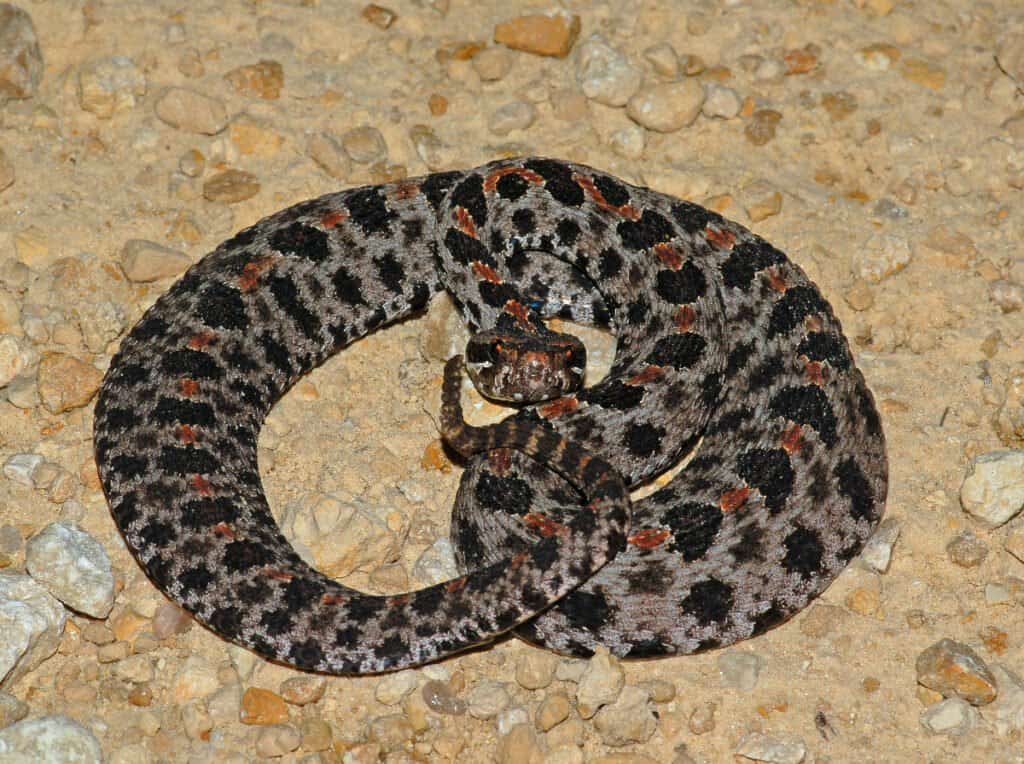
Louisiana is home to 48 different species of snakes.
©Gerald A. DeBoer/Shutterstock.com
Venomous Snakes in Arizona
As you learned above, Arizona is home to several dozens of snake species, with 13 of these being rattlesnakes. In fact, in Arizona, every venomous snake species you’ll come across is a species of rattlesnake, except for one: the Sonoran or Arizona coral snake.
Below, you’ll find more information about each of the venomous snake species you may encounter in this state.
Rattlesnakes
- Massasauga (Sistrurus catenatus)
- Mohave Rattlesnake (Crotalus scutulatus)
- Prairie Rattlesnake (Crotalus viridis)
- Sidewinder Rattlesnake (Crotalus cerastes)
- Speckled Rattlesnake (Crotalus mitchelli)
- Twin-spotted Rattlesnake (Crotalus pricei)
- Tiger Rattlesnake (Crotalus tigris)
- Ridge-nosed Rattlesnake (Crotalus willardi)
- Black-tailed Rattlesnake (Crotalus molossus)
- Western Rattlesnake (Crotalus oreganus)
- Rock Rattlesnake (Crotalus lepidus)
- Arizona Black Rattlesnake (Crotalus cerberus)
- Western Diamond-backed Rattlesnake (Crotalus atrox)
Sonoran Coral Snake
The Sonoran coral snake, also known as the Arizona coral snake or the western coral snake, is the only venomous species of snake in Arizona that is not a rattlesnake. Despite this, however, it is still a highly venomous species that can pose a high risk to humans who may be bitten. Because of this, the Sonoran coral snake should never be handled directly, and if seen in the wild, it shouldn’t be approached. Although they have caused less human deaths than rattlesnakes, wild encounters between this species of coral snake and humans can be dangerous for both parties.
This snake gets its common name from the region it lives in. It is native to the Sonora Desert. This area stretches from northwestern Mexico into the southwestern United States, especially in Arizona.
This venomous species would much rather live in the arid plains and slopes of the desert than in greener environments. During the day, the Sonoran coral snake is typically found under logs or rocks. A nocturnal predator, they’re most common on overcast days, Sundays, or at night.
At first glance, you probably couldn’t tell that this coral snake species is one of the most venomous snakes in the United States. It’s fairly small, only growing up to a maximum of 24 inches. It’s around the same size as a pencil based on diameter. However, it sports the traditional colors of a North American coral snake. The entire length of its body is covered in red and black bands separated by thin, light yellow bands.
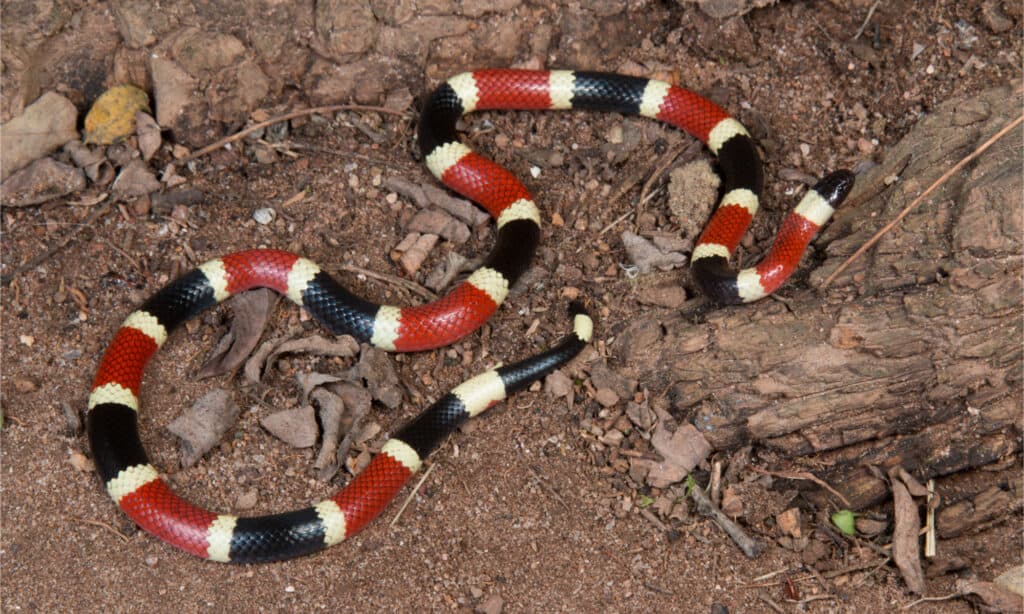
The Sonoran coral snake is the only venomous species of snake in Arizona that is not a rattlesnake.
©Nathan A Shepard/Shutterstock.com
Venomous Snakes in Louisiana
Although it may not be the state with the most venomous snakes, many snakes in Louisiana rely on venom for hunting and protection. Louisiana is home to three different rattlesnake species. One of these is the eastern diamondback rattlesnake, the largest rattlesnake in the world and the most venomous snake in all of North America. However, Louisiana also has four other species of venomous snake.
Rattlesnakes
- Pygmy rattlesnake (Sisturus miliarius)
- Eastern diamondback rattlesnake (Crotalus adamanteus)
- Timber rattlesnake (Crotalus horridus)
Eastern Copperhead
Outside of rattlesnakes, the eastern copperhead is one of the most well-known venomous snakes in the southeastern United States, making them a staple species in Louisiana. However, copperheads are endemic to most of eastern North America, meaning that they can thrive in a variety of other places as well.
They have a reddish brown body that is thickly built and heavy, with adults growing to be around 20 to 37 inches with the tail included. There is one tell-tale marking to help you identify the eastern copperhead, however. Along the length of their body, you’ll find they have several dark marks in the shape of an hourglass.
Eastern copperheads favor woodlands and forests. In these areas, it can thrive in a variety of different habitats, ranging from rocky terrains to swampy lowlands. This is why they are able to thrive in Louisiana. Like many other species of reptiles, eastern copperhead snakes will hibernate in the winter. During this time, it is not uncommon to find that eastern copperheads will settle into dens or crevices along with other species of snakes, including timber rattlesnakes and black rat snakes.
One of the most important things to know about the eastern copperhead is that, unlike other species of snakes, the eastern copperhead will typically not flee from humans. Instead, they will often freeze when threatened. This is because their dark coloration allows them to blend into the fallen leaves of the forest floor. As a result, when they feel threatened, they’re likely to freeze and take advantage of this camouflage.

Along the length of their body, eastern copperheads have several dark marks in the shape of an hourglass.
©Jeff W. Jarrett/Shutterstock.com
Texas Coral Snake
Although this species of coral snake has Texas in the name, this isn’t the only state that it’s found in. Instead, they’re one of the venomous species of snake that you’ll find in Louisiana.
Like other species of coral snakes, including Arizona’s Sonoran coral snake, the Texas coral snake is nocturnal. During the day, it’ll spend the majority of its time out of sight. Usually, they’ll either be underground or hiding beneath natural materials such as leaves or bushes. At night, they’re more likely to be active. This is when they’ll move around the most and seek out their prey. Texas coral snakes live in many habitats, from wetlands to forests. They are most commonly seen during the warm, humid weather following heavy rainstorms, making them a staple species in Louisiana.
Like other species of coral snakes native to North America, the Texas coral snake sports bands in red, black, and yellow. A yellow band will separate each black and red band, which can be an easy way to tell coral snakes from king snakes. However, this isn’t always accurate, which is why it’s important to avoid interacting with or handling wild snakes.
This is especially true considering that Texas coral snakes have the second most powerful venom in the entire world. Thankfully, however, healthcare technology has progressed far enough to save many would-be fatal encounters with the Texas coral snake. Since antivenom for this species has become available, there have been no deaths, leaving the last Texas coral snake fatality in the 1960s.
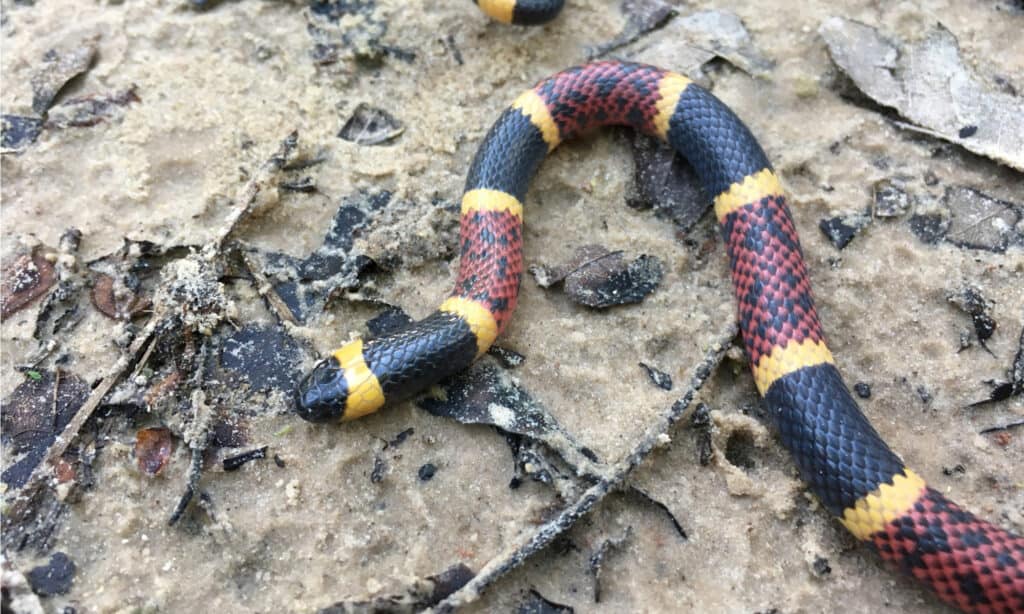
The Texas coral snake sports bands in red, black, and yellow.
©Joe Farah/Shutterstock.com
Eastern Coral Snake
The eastern coral snake is another coral snake species native to Louisiana. They are the species most commonly mimicked by the kingsnake. Eastern coral snakes are similar to the Texas coral snake, thriving in similar areas. They have wider black bands on their body, with thin yellow bands between the red and black bands.
Most eastern coral snake bites occur as a result of handling. Typically, if you are bitten by an eastern coral snake, it will not release until the venom has been injected. With prey, this helps ensure the venom begins to work in the body.
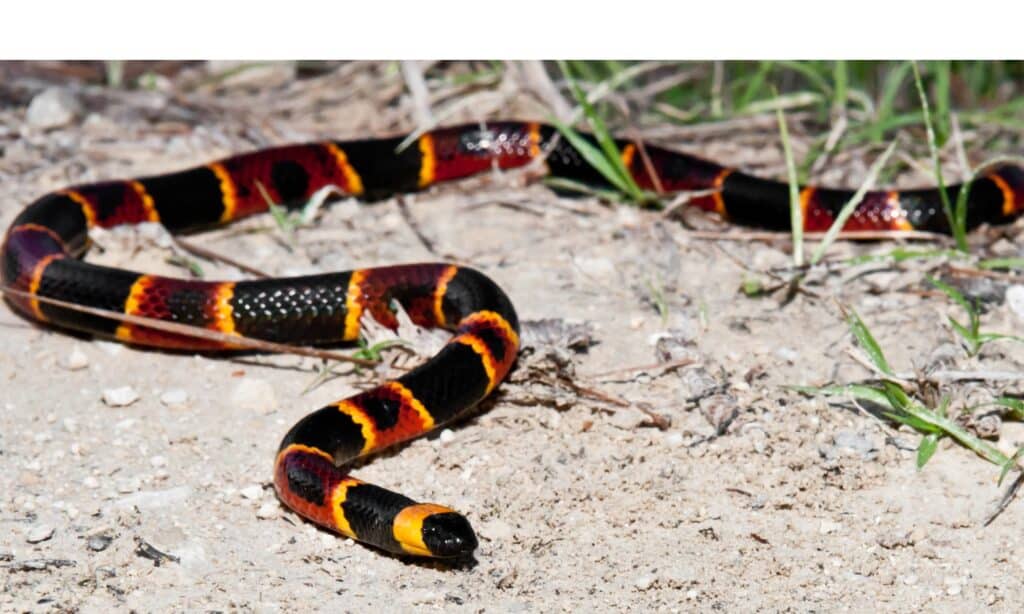
The eastern coral snake has thinner bands of yellow than the Texas coral snake.
©iStock.com/JasonOndreicka
Northern Cottonmouth
Northern cottonmouths are also known as water moccasins or simply as cottonmouths. They are a common venomous species throughout the eastern United States. Because they are a semi-aquatic species that live on frogs, toads, fish, and other similar animals, so they thrive in wet areas. This means the bayous and swamps in Louisiana are prime examples of their preferred habitats.
It can be difficult to identify a northern cottonmouth snake. They have dark brown or black body with few distinguishing features. The best feature that works to help identify the north cottonmouth is the inside of its mouth. While other snakes may have a pink or pale red mouth, the mouth of the cottonmouth is a bright, stark white. This is where their common name comes from.
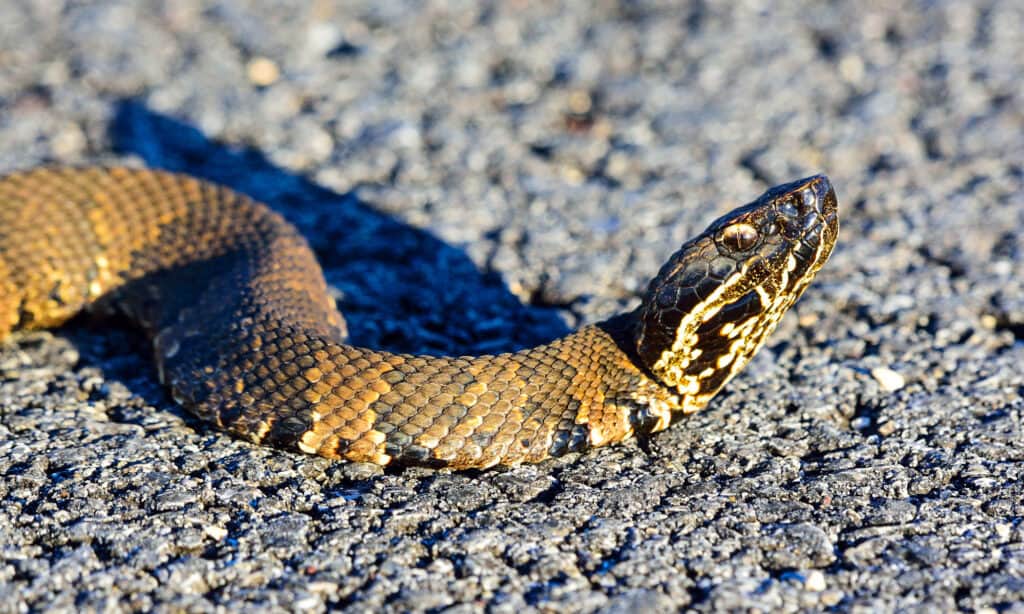
Bayous and swamps in Louisiana are prime habitats for the venomous northern cottonmouth.
©Ad Konings/Shutterstock.com
What to Do if You Are Bitten by a Venomous Snake
A bite from a venomous snake is a medical emergency. However, it is important not to panic.
First, you will need to contact emergency services immediately. The sooner you receive care, the sooner antivenom can be administered to minimize the harm caused by the attack. As you learned above with the Texas coral snake, antivenom can be the difference between life and death.
While you wait, keep the bite wound below your heart. This means that if the bite is on your hand, as is most common with handling, don’t raise your hand higher than your heart. Don’t apply a tourniquet, attempt to suck the venom, cut the wound, or attempt to apply pressure. While these may be proper first-aid protocols for other wounds, they can make a snake bite worse.
The photo featured at the top of this post is © iStock.com/HRossD
Discover the "Monster" Snake 5X Bigger than an Anaconda
Every day A-Z Animals sends out some of the most incredible facts in the world from our free newsletter. Want to discover the 10 most beautiful snakes in the world, a "snake island" where you're never more than 3 feet from danger, or a "monster" snake 5X larger than an anaconda? Then sign up right now and you'll start receiving our daily newsletter absolutely free.
Thank you for reading! Have some feedback for us? Contact the AZ Animals editorial team.






